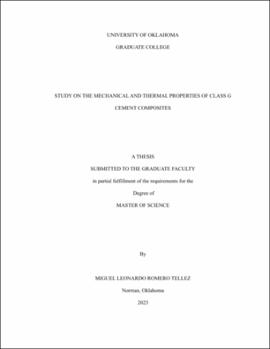| dc.description.abstract | Nowadays the consumption of hydrocarbons such as oil and gas are higher than ever before, for that reason, the world is constantly looking for the development of new oil formations that were not accessible before due to the lack of technology for high-pressure and high-temperature reservoirs, being the trigger of new well construction materials that can achieve the new requirements that the industry currently needs. Simultaneously, as the oil and gas industry endeavors to satisfy this growing demand for hydrocarbons, there's a concerted effort to transition towards a more sustainable, environmentally friendly future.
For this reason, the oil and gas industry is moving to carbon-neutral alternatives to materials like cement, that is fundamental in the operation since provides well integrity, which currently has a significant carbon footprint. Cement production accounts for a substantial portion of CO2 emissions, the production of one kilogram of cement send one kilogram of CO2 to the atmosphere, contributing to approximately 9% of annual CO2 emissions produced by humans, underlining the urgency to find greener alternatives.
One of the materials that aligns with the new goals the oil and gas industry is trying to achieve regarding CO2 emissions and have the desirable characteristic to develop slurries for well cementing are geopolymers. It is a relatively cheap material that is characterized by having a high resistance to acidic environments, high compressive strength, and a low carbon footprint due to the fact is a waste material from other industrial processes.
This thesis focuses on the experimental testing and analysis of the compressive strength of neat class G cement, as well as class G cement with the addition of class F fly ash at different percentages (10%, 20% and 30% were the cement composites selected, above 30% the cement slurries were not able to be mixed, hence the study stopped at 30% fly ash by weight of cement) at both room and high temperature. Additionally, the characterization and analysis of the same class G cement composites but with the addition of sodium hydroxide to the mixture cured at high temperature. Similarly, the research aimed to experimentally test and analyze the thermal properties of neat class G cement and class G cement composites with the addition of fly ash at different percentages, cured at room temperature, to assess their thermal properties. All of the tests done in this research were conducted for a period of 28 days.
In conclusion, this research reveals that increasing the percentage of fly ash in class G cement composites directly enhances compressive strength consistently across varying environmental conditions. On the other hand, the addition of sodium hydroxide negatively impacts compressive strength by altering pH levels and hindering the formation of critical components, highlighting its adverse effect on cement properties. Finally, the results of the thermal properties were not conclusive when the Keithley 2400 meter with TPS-3 was used suggesting the need of a longer period of time for testing to ensure the stabilization of the values to finally lead to a conclusion. Whereas the results obtained using the Thermtest Portable Measurement Platform −2 concluded that the more fly ash incorporated into the class G cement sample the more is going to be the increment of the thermal conductivity, this being true up to 20% fly ash added by weight of cement. When 30% fly ash by weight of cement was added it was possible to see a slight decrease of this property. | en_US |

